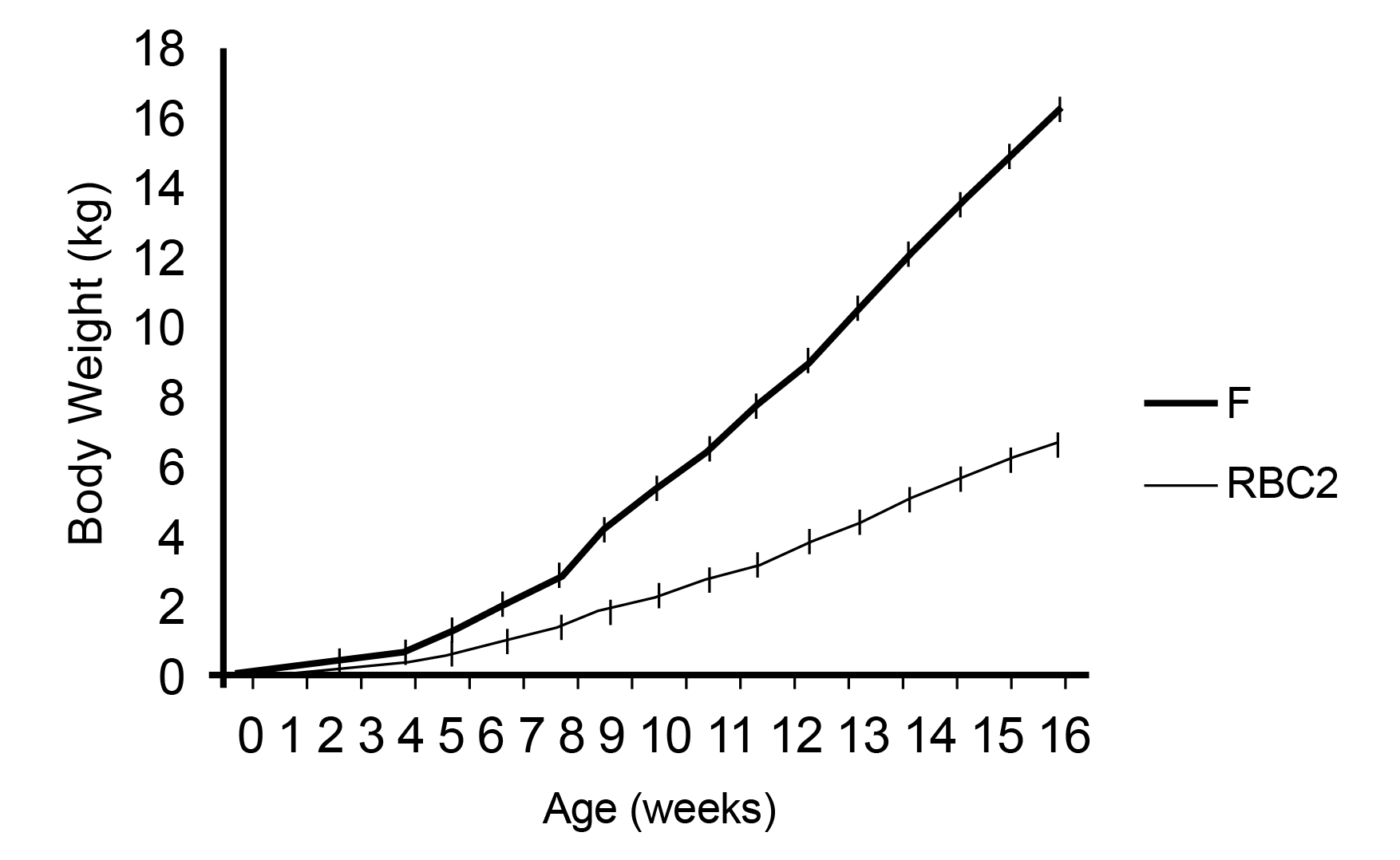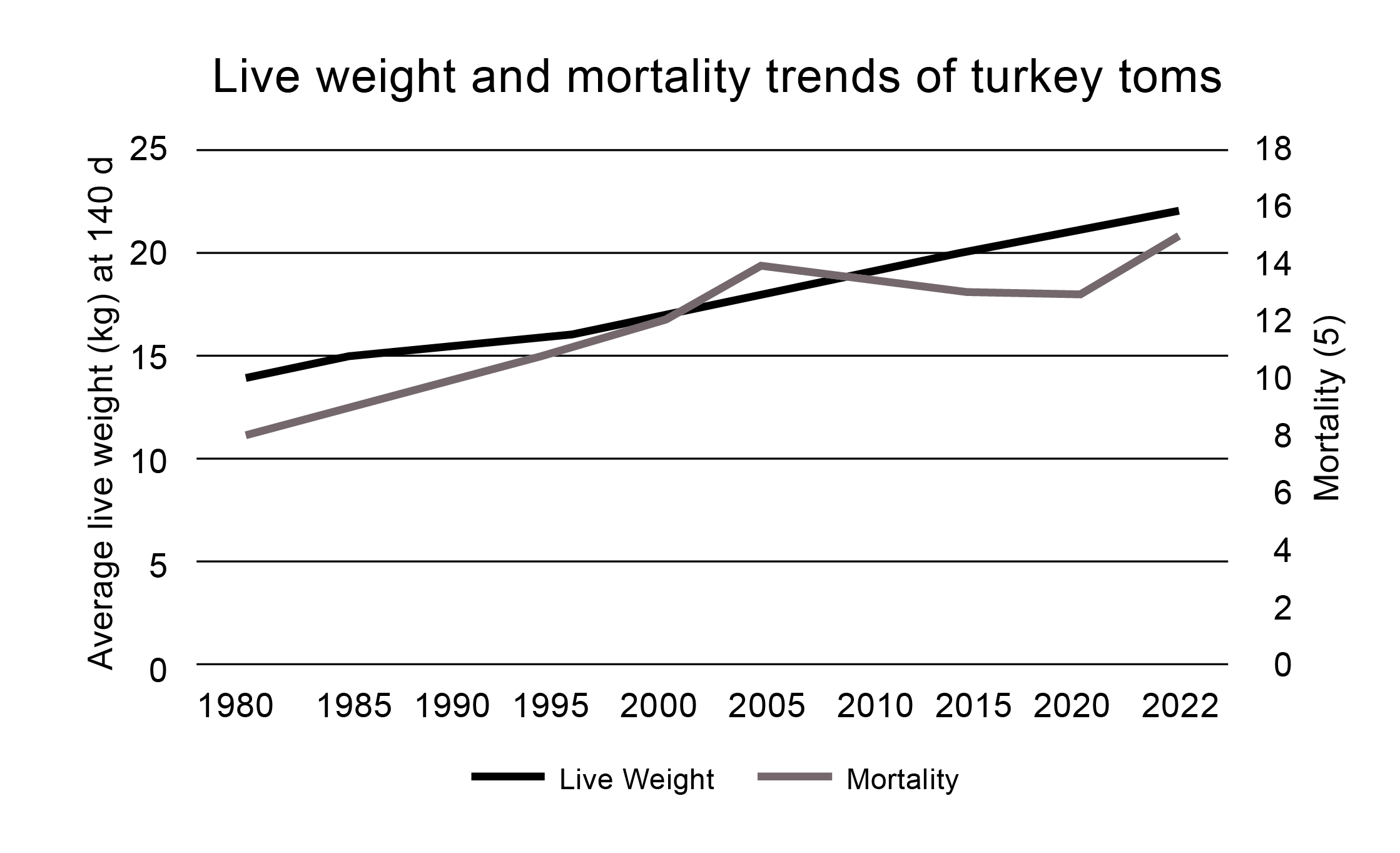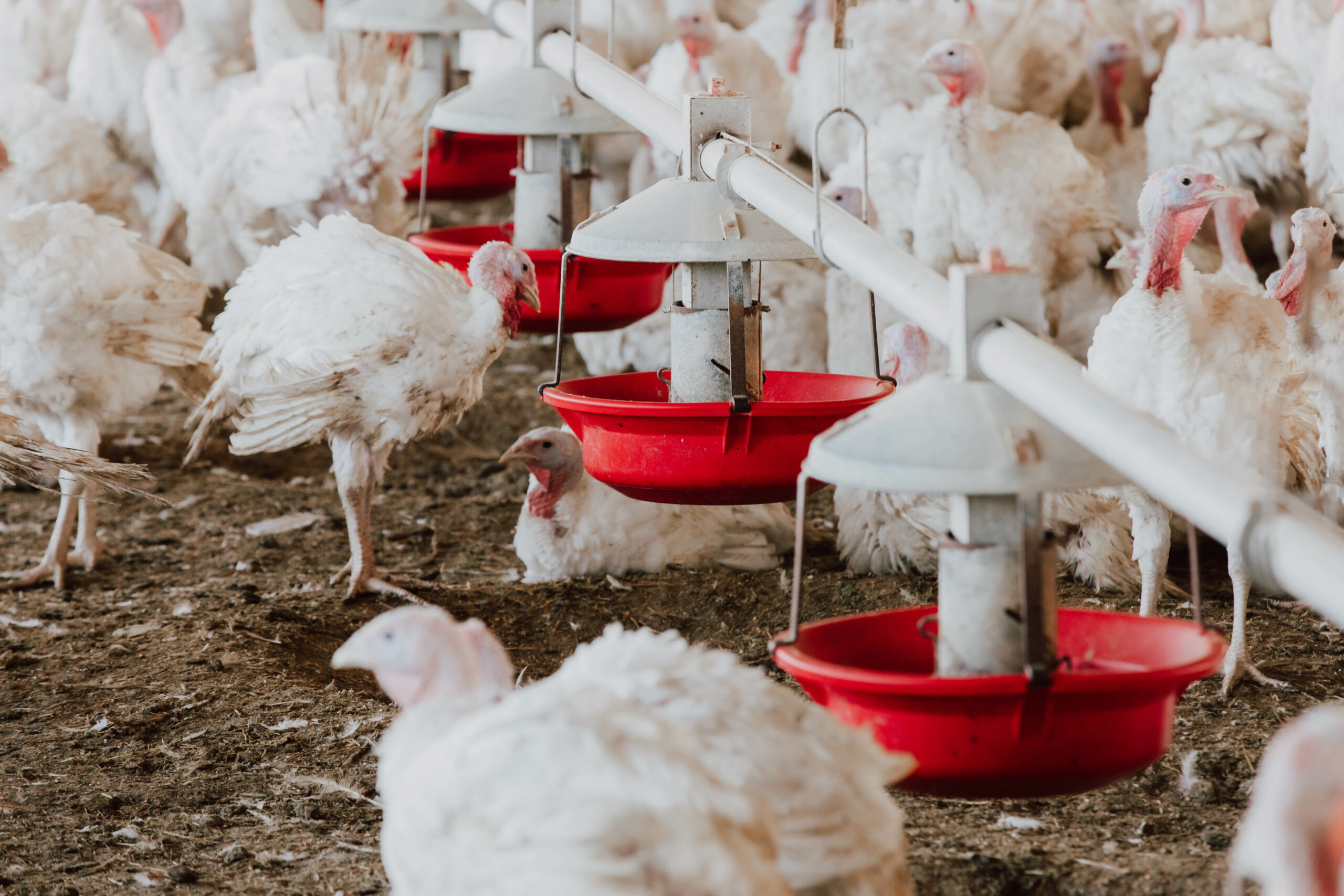By Ky Meeks, Ph.D.
Modern turkey toms grow faster and larger than they did 60 years ago, growing to nearly 50 pounds by 20 weeks of age (Aviagen Turkeys, 2022; Hybrid Turkeys, 2022b). At the same age, this is more than double the weight of the random-bred control turkey line (RBC2; Figure 1), a genetic representative of turkey strains from the 1960s housed by Ohio State University (Havenstein et al., 2007; Clark et al., 2019).
Figure 1.

Figure 1. Clark et al. 2019. Growth performance of F – and RBC2 turkey tom lines. F – line: Line of turkey toms that has been selected for body weight at 16 weeks and is similar to modern commercial turkey toms. RBC2: random-bred line that is representative of 1960s commercial turkey tom genetics.
Modern toms also have a much better feed conversion ratio (FCR; feed intake/body weight) than older generations, with toms in 2003 reaching 11 kilograms body weight at 98 days with an FCR of 2.1, and RBC2 toms reaching 11 kilograms body weight at 196 days with an FCR of 4.2 (Havenstein et al., 2007). Thus, modern toms are much more feed efficient than previous generations of tom genetics.
Modern turkey toms pack on the pounds, most notably in their breast meat, having a breast meat yield of nearly 25 percent live body weight and nearly 33 percent of their carcass weight at 18.5 weeks of age (Walk et al., 2023). For comparison, breast meat yield of 1960s genetic representative turkeys were less than 20 percent of live body weight at 16 weeks of age (Updike et al., 2005).
The growth potential of turkey toms has increased over the last 60 years, but the scientific literature has shown that mortality rates have followed this same trend (Figure 2). This leads to somewhat of a dilemma: how does one feed the modern turkey?
Figure 2.

Figure 2. Average live weight and mortality rate trends of turkey toms since 1980. Graph adapted from data presented by Owen Willems, PhD – Hendrix Genetics, at 2023 PEAK conference.
As poultry nutritionists, we formulate diets to grow a healthy bird that will produce meat and make it to market on both legs. This is especially important for modern toms. To formulate proper diets, we must consider many components such as the dietary levels of protein, energy, vitamins, minerals, and health additives. These considerations can change based on factors including age of bird, health status of the birds, and the time of year. All components and factors must be considered closely, as improper nutrition can affect birds on top of any disease challenges that may be seen.
Protein
Turkeys do not have a requirement for protein per se, but requirements for amino acids, the building block of proteins. Young poults will typically have a higher dietary percentage of protein ingredients, such as soybean meal or meat and bone meal, than older toms. This is because turkey poults have higher amino acid requirements to meet their needs for early rapid growth of the musculoskeletal and organ systems. A trend of higher amino acid recommendations in national research council (NRC) recommendations published over the last half-century (National Research Council, 1977, 1984, 1994), as well as the most recent genetic company recommendations (Aviagen turkeys, 2010; Hybrid Turkeys, 2022a), suggests the modern tom has a higher amino acid requirement than past generations of tom genetics to sustain their rapid rate of growth.
Energy
Energy levels in turkey diets are very important for bodily growth. All processes inside an animal require energy to occur. High energy ingredients that are typically seen in turkey diets include corn and a fat/oil source. Opposite of protein, tom diets will typically have higher levels of energy ingredients than poult diets. Tom diets will have much higher energy than poults as toms are heavier and thus have a higher maintenance energy requirement, which must be met to maintain their weight, and then overcome to grow and add body weight. Fat sources are very high in energy, containing approximately 3x the energy of corn (Fowler, 2019), and therefore are commonly used to elevate dietary energy levels with a lower inclusion rate than corn. Physiologically, young poults are also limited in their ability to digest energy. The activity of protein and carbohydrate enzymes increase rapidly during the first 21 days post-hatch in poults, however, the lipid enzyme lipase does not begin increasing until after 21 days of age (Krogdahl and Sell, 1989). Similarly, it has been demonstrated that fat sources have lower metabolizable energy levels in 2 week old poults than in 8 week old poults, potentially due to lower activities of fatty acid binding proteins and bile salt secretions in younger poults (Sell et al., 1986). This indicates there is likely an age-related ability to digest energy from fat sources, which is why young poult diets will have less added fat than older birds.
Vitamins
Vitamins are compounds that cannot be synthesized by the body and are essential for normal bodily functions and growth. All vitamins have specific deficiency symptoms, and some have been found to have toxicity symptoms. Two typical classifications of vitamins are fat-soluble and water-soluble vitamins. There are four fat-soluble vitamins: A, D, E, and K. As the name of this classification suggests, these vitamins require some sort of fat to be in the diet for their optimal uptake into the body. The fat-soluble vitamins have longer half-lives in the body than water-soluble vitamins as they are readily stored in adipose tissue, which is why they are more prone to cases of deficiency and/or toxicity. Vitamins A and D are essential for many bodily processes including growth of muscles, bones, and the immune system. Vitamin E is a potent antioxidant that is important for metabolic processes as well as maintaining stability of feed, and vitamin K is essential for blood coagulation. Recommendations for the levels of these vitamins in turkey diets have increased through the years (National Research Council, 1994; Aviagen turkeys, 2010), likely to support the elevated growth rate of modern turkeys, but also to mitigate the chance of developing deficiencies that negatively impact growth. This can also be because it has been found that inclusion levels above the recommended values can have benefits on growth performance (Ognik and Wertelecki, 2012) and immunity (Sklan et al., 1995).
The water-soluble vitamins are all other vitamins that have been described in the literature, which includes the large group of B-vitamins, vitamin C, and others. These vitamins are not stored in the body at high concentrations, and therefore have lower risk of causing toxicity than fat-soluble vitamins. Unlike humans, birds can produce vitamin C as their bodies produce the enzyme gulonolactone oxidase, and therefore it is very unlikely for this vitamin to be supplemented into turkey diets. Similar to the fat-soluble vitamins, recommendations for the levels of the vitamins in turkey diets have increased over time (National Research Council, 1994; Aviagen turkeys, 2010), likely to support the elevated growth rate of modern turkeys and to reduce the chance of developing deficiency symptoms.
Feed ingredients contain varying levels of vitamins, but rarely have enough to suffice the needs of a rapidly growing turkey. Therefore, vitamins are typically supplemented into diets as a premix, as they have low inclusion levels.
Minerals
Minerals are elements on earth and in food that bodies need to function normally. In nutrition, minerals are divided into macro-minerals and micro-minerals, of which turkeys have requirements for many of each division. Examples of macro-minerals include calcium, phosphorous, sodium, and chloride. Calcium and phosphorous are essential minerals for the structural integrity of bones. Similar to amino acids and vitamins, research has shown that modern birds perform better when inclusion levels of calcium and phosphorous are higher than previous NRC recommendations (Roberson et al., 2004). Recommendations for sodium and chloride have increased slightly over time (National Research Council, 1994; Aviagen turkeys, 2010), but these minerals are more of a concern for being over fed. As reviewed (Shepherd and Fairchild, 2010), elevated levels of sodium and chloride in a poultry diet can lead to wet litter due to increased water intake, which can then cause increased barn ammonia levels and footpad dermatitis, among other issues.
Examples of micro-minerals include zinc, copper, and selenium. Zinc plays pivotal roles in the body, including skeletal health, immunity, and is a strong antioxidant. Zinc is considered to be very important to function as an antioxidant during times of heat stress (Sahin et al., 2009). Zinc and copper both have strong antibacterial activity in the intestinal lumen of poultry (Duffy et al., 2018), typically being fed at supranutritional levels and are therefore higher in modern dietary recommendations (Aviagen turkeys, 2010). Selenium is considered to have major antioxidant properties through its role as a component of selenoproteins, such as the powerful antioxidant glutathione peroxidase. Through this role, selenium has a synergistic relationship with vitamin E (Özkan et al., 2007). The United States Food and Drug Administration currently limits the supplementation of selenium supplementation into diets to 0.3 mg/kg (F.D.A., 2012).
Health Additives
Health additives will routinely be added to turkey diets. Some of these include anticoccidials, probiotics, prebiotics, toxin-binders, essential oil blends, spice extracts, and other plant-derived products. The benefits of these additives range from improved growth to reduced incidence of disease and mortality. These additives are usually associated with gut health of the turkey, which is pertinent for the absorption of dietary nutrients. Anticoccidials are compounds that target the coccidiosis causing species Eimeria, and they are typically ionophores. Probiotics are live strains of bacteria that are used to establish particular strains of bacteria in the intestinal microbiota. Prebiotics are materials that are relatively indigestible to the animal and are used as a source of energy for bacteria in the intestines that will allow for the growth of bacteria that are considered to be beneficial to gut health. Toxin-binders are used to bind to toxins of fungal origin, such as aflatoxins, as well as bacterial origin, such as the endotoxins produced by E. coli. Essential oil blends and spice extracts are newer products on the market that may have beneficial impact on gut health through different mechanisms than antibiotics, making them potential antibiotic alternatives. On top of keeping all nutrient levels at and above their basic requirements, nutritionists use many of these health additives to keep their turkeys healthy and minimize mortality.
In closing, there are many factors at play to feed the modern turkey. Modern turkeys have great potential for growth, but they must be kept healthy to reach this potential. As demonstrated in this writing, there are many areas where growth and health can be impacted by nutrition. On top of the nutritional aspect, turkeys must be kept relatively disease and stress-free to maximize their growth performance.
References
Aviagen turkeys. 2010. Aviagen Turkey commercial feeding recommendation.
Aviagen Turkeys. 2022. Nicholas Select Performance Objectives.
Clark, D. L., K. E. Nestor, and S. G. Velleman. 2019. Continual selection for increased 16 wk body weight on turkey growth and meat quality: 50 generation update. Journal of Applied Poultry Research 28(3):658-668.
Duffy, L. L., M. J. Osmond-McLeod, J. Judy, and T. King. 2018. Investigation into the antibacterial activity of silver, zinc oxide and copper oxide nanoparticles against poultry-relevant isolates of Salmonella and Campylobacter. Food control 92:293-300.
F.D.A., U. S. 2012. Code of Federal Regulations Title 21, Subchapter E-Animal drugs, feeds and related products. Part 573—food additives permitted in feed and drinking water of animals. Subpart B—Food Additive Listing Sec. 573.920 Selenium.
Fowler, J. 2019. Ingredient Analysis Table: 2018-2019 Edition. Feedstuffs.
Havenstein, G. B., P. R. Ferket, J. L. Grimes, M. A. Qureshi, and K. E. Nestor. 2007. Comparison of the performance of 1966-versus 2003-type turkeys when fed representative 1966 and 2003 turkey diets: Growth rate, livability, and feed conversion. Poultry Science 86(2):232-240.
Hybrid Turkeys. 2022a. Hybrid Commercial Nutrient Calculator.
Hybrid Turkeys. 2022b. Hybrid Performance Goals – Converter Commercial Males.
Krogdahl, Å., and J. L. Sell. 1989. Influence of age on lipase, amylase, and protease activities in pancreatic tissue and intestinal contents of young turkeys. Poultry science 68(11):1561-1568.
National Research Council. 1977. Nutrient requirements of poultry: Seventh revised edition, Washington, DC: The National Academies Press.
National research Council. 1984. Nutrient requirements of poultry: Eighth revised edition, Washington, DC: The National Academies Press.
National Research Council. 1994. Nutrient requirements of poultry: Ninth revised edition, Washington, DC: The National Academies Press.
Ognik, K., and T. Wertelecki. 2012. Effect of different vitamin E sources and levels on selected oxidative status indices in blood and tissues as well as on rearing performance of slaughter turkey hens. Journal of applied poultry research 21(2):259-271.
Özkan, S., H. B. Malayoğlu, S. Yalcin, F. Karadaş, S. Koçtürk, M. Cabuk, G. Oktay, S. Özdemir, E. Özdemir, and M. Ergül. 2007. Dietary vitamin E (α-tocopherol acetate) and selenium supplementation from different sources: Performance, ascites-related variables and antioxidant status in broilers reared at low and optimum temperatures. British Poultry Science 48(5):580-593.
Roberson, K. D., M. W. Klunzinger, and R. A. Charbeneau. 2004. Benefit of feeding dietary calcium and nonphytate phosphorus levels above National Research Council recommendations to tom turkeys in the growing-finishing phases. Poultry science 83(4):689-695.
Sahin, K., N. Sahin, O. Kucuk, A. Hayirli, and A. Prasad. 2009. Role of dietary zinc in heat-stressed poultry: A review. Poultry science 88(10):2176-2183.
Sell, J. L., A. Krogdahl, and N. Hanyu. 1986. Influence of age on utilization of supplemental fats by young turkeys. Poultry Science 65(3):546-554.
Shepherd, E. M., and B. D. Fairchild. 2010. Footpad dermatitis in poultry. Poultry science 89(10):2043-2051.
Sklan, D., D. Melamed, and A. Friedman. 1995. The effect of varying dietary concentrations of vitamin A on immune response in the turkey. British Poultry Science 36(3):385-392.
Updike, M. S., H. N. Zerby, J. C. Sawdy, M. S. Lilburn, G. Kaletunc, and M. P. Wick. 2005. Turkey breast meat functionality differences among turkeys selected for body weight and/or breast yield. Meat science 71(4):706-712.
Walk, C. L., C. Alleno, R. Bouvet, J.-M. Thoby, I. Eising, and P. Segobola. 2023. Dietary muramidase improved growth performance, feed efficiency, breast meat yield, and welfare of turkeys from hatch to market. Poultry Science 102(7):102716.

